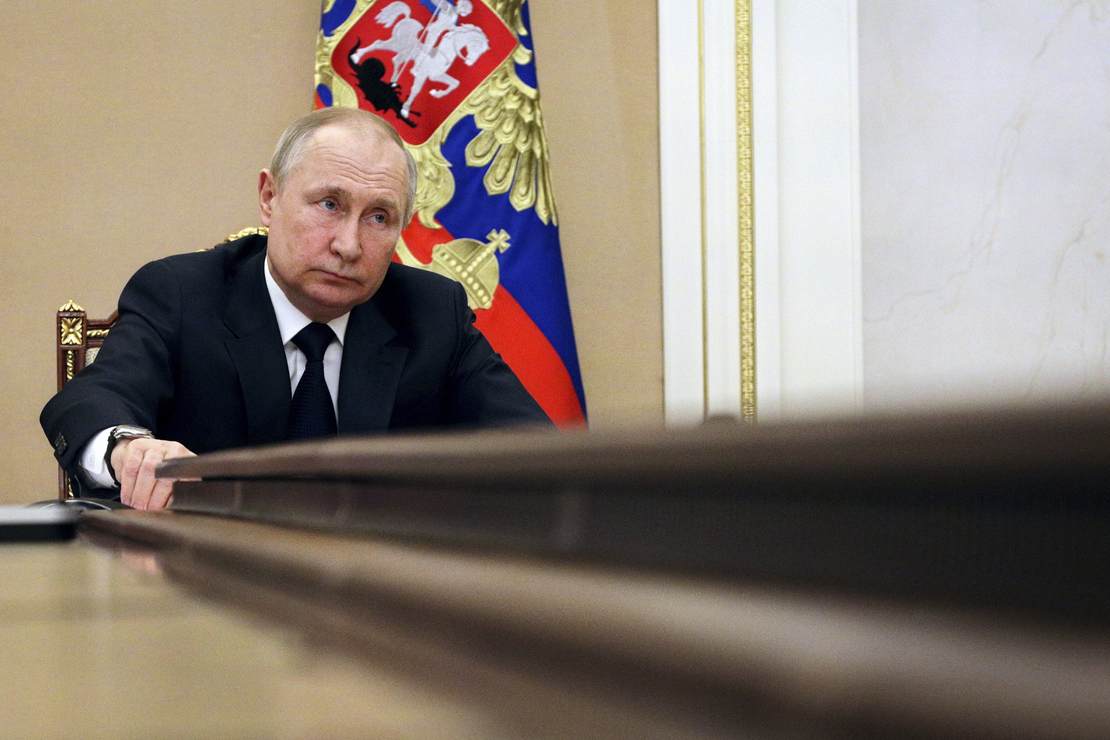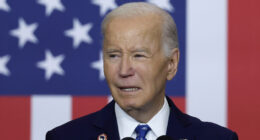
Maybe? The White House thinks so, reports the Washington Post, at least while reviewing what has gotten sent out to sea. Roughly forty percent of Russian oil exports go out by tanker, and the Biden administration thinks that has fallen from 2 million barrels to roughly zero:
Senior Biden aides believe that Russia is suffering a dramatic decline in oil sales that stands to deprive the Kremlin of a key source of government revenue, according to a senior administration official and one person briefed by a senior administration official, both of whom spoke on the condition of anonymity to share an assessment not yet made public.
The Biden administration is examining private industry data showing that sales of Russian crude oil by vessel have gone from roughly 2 million per day to close to zero from the period between March 15 and March 20, the people said. The official said more than 2 million barrels of Russian oil sold per day have been taken out of the market and that Asian buyers are not stepping in to fully fill the gap.
But some analysts believe that Russia will continue to sell huge quantities of oil that will help Moscow fund its invasion of Ukraine — arguing that Congress, the administration and Europe could take more aggressive action to curb sales of Russian energy.
If they can’t sell it by sea, they have to sell it by land. That means pipelines or trucks, and that limits the geographical reach of those sales. Europe won’t buy their oil and natural gas at the moment, and Central Asia has its own supplies. However, India remains very interested in doing business with Russia, in combination with China — as long as the US and EU don’t hit them with retaliatory sanctions, and as long as Russia heavily discounts the crude:
According to a report by Reuters, two Indian officials have said that Delhi might accept crude oil at cheaper prices from Moscow as a key trading partner. This statement has come out in the backdrop of rising sanctions being imposed by western countries on Russia.
Russia, reportedly, is offering oil to India at heavily discounted prices. India and Russia are trying to establish a separate rupee-rouble mechanism to facilitate trade. Once the paperwork related to insurance and pipeline is completed, India might accept the offer, Reuters reported.
The western countries, especially the USA, have distanced themselves from Russia in recent weeks. But for India, the situation is different. According to a report by SIPRI, India is one of the largest importers of weapons in the world. And Russia is India’s largest supplier of weapons. In the last five years, 46 per cent of the country’s imports came from Russia alone.
As mentioned in Reuters, India has a heavy dependency on oil imports too. Almost 80 per cent of its oil needs are imported. With the prices of crude oil rising exponentially in the last few weeks, the government may look at the sources of cheap oil. The deficit and inflation rates in the country have been more than the upper limits fixed by the government.
Delivery might be tricky if Russia isn’t using its tankers. The article mentions a pipeline, but that’s been aspirational for almost an entire decade. After the West first imposed sanctions on Russia over the seizure of Crimea, India and China began negotiating a pipeline that would allow overland delivery of Russian crude. That pipeline would cut through Xinjiang, where the Xi regime is currently committing a genocide against the native Uighurs.
With the latest round of sanctions now strangling Vladimir Putin, suddenly interest from Beijing has rebounded in this pipeline:
In the shifting geopolitical landscape post the Russia-Ukraine crisis, Chinese foreign minister Wang Yi is likely to propose a Russia-China-India (RCI) oil/gas pipeline project during his upcoming New Delhi visit later this month.
The move is said to have been formulated in response to the US sanctions against Moscow not only hitting the economic interests and businesses of Russia but also hitting India and China hard, top sources privy to the development said.
READ RELATED: Jim Lamon Age, Net worth, Wikipedia, Family, Wife, Ex-wife, Religion
The possible proposition of the RCI Pipeline project comes in the backdrop of the Tajikistan-Afghanistan-Pakistan-India (TAPI) Pipeline not taking off due to security risks posed by a destabilised Kabul and the perennial anti-India stance of Islamabad. …
Taking advantage of its sanctions against the Kremlin, the US has been seeking to leverage with New Delhi to further enlarge its defence procurement from Washington which has even threatened India with sanctions under Countering America’s Adversaries through Sanctions Act (CAATSA) for the acquisition of S-400 missile defence systems from Russia, the sources said.
However, New Delhi is in no mood to budge and spoil its decades-long strategic relations with Moscow, especially with a firm realisation here that not only American defence assets are costly but investments in technology transfers in India by the US in the sector are low as compared to Russia, they said.
Needless to say, that puts New Delhi in the catbird seat, geopolitically speaking. It would appear that India’s playing “Let’s Make a Deal” with Biden, Putin, and Xi — and why not? So is Xi:
During the likely visit of Yi, a proposal of Alternative Payments System (APS) between Russia, China and India to offset the impact of the sanctions against the Kremlin, including the removal of Moscow from the SWIFT payment system, is also likely to come up. Initially, Russia, China and India could be the part of the proposed APS and subsequently more countries can join the grouping, shifting the global order in the process by shaking off the dominance of the American Mastercard and Visa.
Yes, but that’s a trap for India too. They may prefer Moscow as a supplier, but they need access to SWIFT, as does China, if they want to trade broadly with the West. The US and EU have just given a pretty brutal demonstration of what can happen if other countries seriously cross them, and neither India nor China can afford to write off access to Western economies. (For that matter, neither can Putin, who may have been stunned to discover that would be a consequence of his Ukraine war.)
Of course, the pipeline won’t do diddly-squat for Putin or India until it gets built. That will take years, and likely would become a major Belt and Road Initiative project for Xi, with all that entails for both India and Russia. Putin doesn’t have much choice but to go along, but Narendra Modi will have to ask himself just how much cheap oil will make up for becoming a Beijing toady and surrendering sovereignty over the parts of India where the pipeline runs. China doesn’t offer this kind of assistance out of the goodness of its communist heart, after all.
If the White House is correct, by the way, it means that some countries stopped buying sea-shipped oil from Russia before the invasion:
Most oil is sold 30 days before loading, and it can be days more before a shipment gets to its destination, so it may be a while before Russian oil deliveries reflect sales since the invasion. “If you stop buying crude that was going to be loaded mid-March, the impact of that doesn’t start getting really felt until April,” Andy Lipow, an oil industry consultant based in Houston, told DealBook.
That’s led to a hunt for clues in energy industry data.
Matt Smith, an oil analyst with the analytics firm Kpler, has been watching individual ships. Last week, he noticed a tanker carrying Canadian oil that left for Ireland from a U.S. Gulf port, a combination he hadn’t seen before. Mr. Smith says the unusual route may suggest that Europe is starting to diversify its supplies. “There are a few tentative signs that flows from elsewhere are picking up,” he said.
Maybe the EU was a bit more pro-active than first thought. We’ll see soon enough whether global shipments from Russia have really collapsed, or whether they’re just getting creative about transportation. Unfortunately, one key indicator of this will be the price of oil and then gasoline at the pumps, unless enough production comes on line to replace Russia’s output. We won’t see that coming from domestic producers, not unless Biden suddenly changes direction and cuts the red tape on drilling and extraction in the US.
Source:






